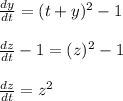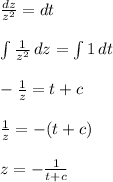Answer:
![y = - [ (1)/(t - (28)/(9) ) + t ]](https://img.qammunity.org/2021/formulas/mathematics/college/rgw3hok46ytjkc19u06j5twmafe8ekw8yr.png)
Explanation:
Solution:-
- A change of variable is a technique employed in solving many differential equations that are of the form: y ' = f ( t , y ).
- Considering a differential equation of the form y' = f ( αt + βy + γ ), where α, β, and γ are constants. A substitution of an arbitrary variable z = αt + βy + γ is made and the given differential equation is converted into a form: z ' = g ( z ).
- This substitution basically allow us to solve in-separable differential equations by converting them into a form that can be separated, followed by the set procedure.
- We are to solve the initial value problem for the following differential equation:

First Step: Make the appropriate substitution
- We will use a arbitrary variable ( z ) and define the our substitution by finding a multi-variable function f ( t , y ) that is a part of the given ODE.
- We see that the term ( t + y ) is a multi-variable function and also the culprit that doesn't allow us to separate our variables.
- Usually, the change of variable substitution is made for such " culprits ".
- So our substitution would be:

Second Step: Implicit differential of the substitution variable ( z ) with respect to the independent variable
- In the given ODE we see that the variable ( t ) is our independent variable. So we will derivate the supposed substitution as follows:

Remember: z is a multivariable function of "t" and "y". So we perform implicit differential for the variable " z ".
Third Step: Plug in the differential form in step 2 and change of variable substitution of ( z ) in the given ODE.
- The given ODE can be expressed as:
 ... Separable ODE
... Separable ODE
Fourth Step: Separate the variables and solve the ODE.
- We see that the substitution left us with a simple separable ODE.
Note: If we do not arrive at a separable ODE, then we must go back and re-choose our change of variable substitution for ( z ).
- We will progress by solving our ODE:

Where,
c: The constant of integration
Fifth Step: Back-substitution of variable ( z )
- We will now back-substitute the substitution made in the first step and arrive back at our original variables ( y and t ) as follows:
![t + y = - (1)/(t + c) \\\\y = - [ (1)/(t + c) + t ]](https://img.qammunity.org/2021/formulas/mathematics/college/a7h67bz0btsz5n8z01pjdlaa0bcifjc00c.png)
Sixth Step: Apply the initial value problem and solve for the constant of integration ( c )
- We will use the given initial value statement i.e y ( 3 ) = 6 and evaluate the constant of integration ( c ) as follows:
![y ( 3 ) = - [ (1)/(3 + c) + 3 ] = 6 \\\\(1)/(3 + c) = -9\\\\3 + c = -(1)/(9) \\\\c = - (28)/(9)](https://img.qammunity.org/2021/formulas/mathematics/college/nqixdi5gal8wpdtmc7pybopmmdo9gerr0l.png)
Seventh Step: Express the solution of the ODE in an explicit form ( if possible ):
![y = - [ (1)/(t - (28)/(9) ) + t ]](https://img.qammunity.org/2021/formulas/mathematics/college/rgw3hok46ytjkc19u06j5twmafe8ekw8yr.png)